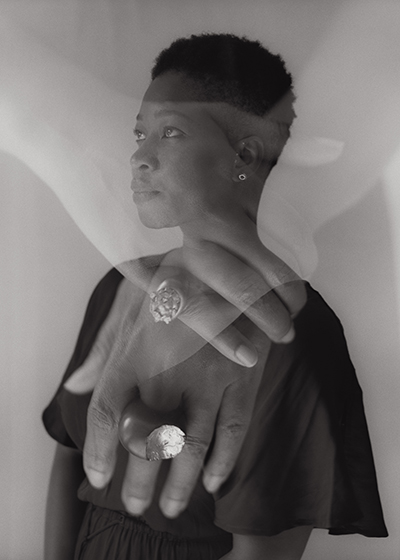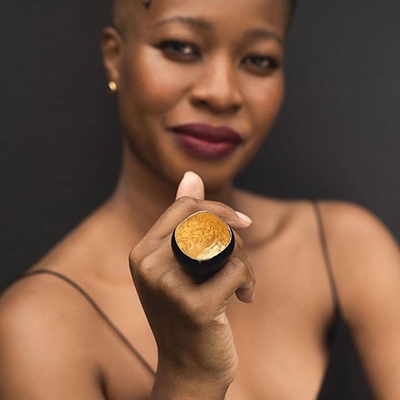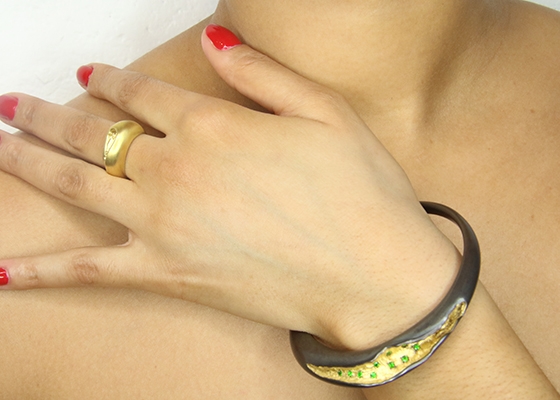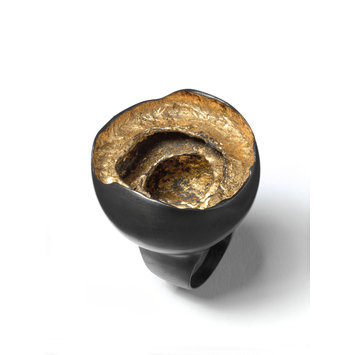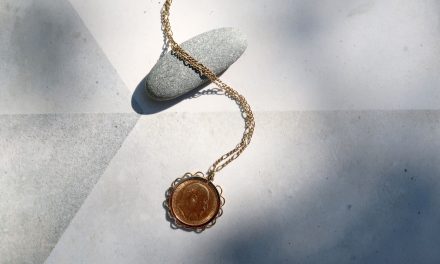Fashion Crush: Emefa Cole
All Images: Emefa Cole
Jewellery isn’t just something we wear, it’s a reflection of our values and our personality. It’s where we’ve been and where we’re headed. No one embodies this feeling like Emefa Cole.
In times of uncertainty we look to the steadfastness of nature to ground us. Coupled with the process of using old techniques to make things with our hands, these two organic processes have been a lifeline for many during 2020. Jeweller Emefa Cole is inspired by nature and by time. Both by ancient techniques and by the idea of decay and renewal. She is arguably, the jeweller we needed for 2020. As her star continues to rise, (she was recently featured in Vogue) she spoke to Lucy Kebbell about her inspiration and hopes for the future via a Zoom call.
An Unexpected Calling
Emefa was born in Ghana but considers herself a proud Londoner having moved here as a preteen. She does however have powerful memories of life in Ghana, memories that have shaped her work. “I remember the first piece of jewellery I bought in a night market in Akra,” she told me. “And of stringing Job’s tears to make necklaces. I was also an avid collector of butterflies.” Her love of natural things began at a young age. However she didn’t immediately recognise her path as a jeweller. “I was about to start a forensic science [course] but my neighbour reminded me I wasn’t fond of creepy crawlies,” she laughs. By chance she discovered an advert for a jewellery design and silversmithing course and decided to take the plunge. She’s never looked back.
Whilst her years at The Cass studying jewellery were vital to her, she admits that it was in the years post graduation that she learnt the most. “When I left I didn’t have access to all the expensive equipment. So I had to figure out how I could carry on making jewellery myself.” She turned instead to wax carving. In this technique, which she taught herself, she found her calling. The hands on method is responsible for the organic designs she produces today. “Nature is mysterious, I find it very beautiful. Decay and renewal, the constant cycle of beauty, destruction, death and rebirth are all inspirations for my collections.” With names like Erosion and Vulcan, her collections are inspired by and pay homage to the power of nature. They are also utterly unique. “I don’t have a specific wearer in mind. Thoughts come to me and I start to draw or create directly with wax.” The process is organic itself, meaning the outcome is often revealed through the process of making.
Traditional Jewellery Making Techniques
As an avid learner, Emefa has also looked to the ancient techniques used in Ghana to explore the narratives she loves. “The fundamentals of jewellery making are as old as us,” she tells me. It was on a trip to Ghana where she studied the Ashante method of casting. “I was very fortunate that I knew someone, who knew someone and I was granted permission by the King of the Asantehene to go and learn with his Royal Goldsmith.” Recognising the uniqueness of this situation she was humbled by the education she received from the Goldsmith, learning with him intensively for two weeks. She hopes to go back for a longer stint very soon. “The Ashante method is a very unique way of casting because it enables them to create large hollow sculptural pieces,” Emefa explains. Sculptures are first made from a clay and charcoal mix. Fine sheets of beeswax are prepared which are then laid over the clay core. It’s a style of casting known as a lost wax gravity technique which is ‘closed circuit’.
The technique is ancient, and unique, and is thought to have originated from the Nok Culture, one of the earliest known societies of Western Africa. She laments that “there is a notion that there couldn’t have been an advanced civilisation in sub saharan Sfrica [using such techniques] with evidence of it’s origins pointing instead to Egypt or other European gazes.”
With roots in Africa, and a belief in it’s riches, the use of such a traditional technique makes perfect sense to Emefa’s work. She cast 6 rings this way when she was in Ghana. As for the rest of her collections, she continues to work tirelessly by hand, using ethically sourced materials. First carving each piece in wax, the pieces are then cast by her casting house, who use only recycled materials. Working mainly in silver, gold and bronze, she also experiments with the metals to create interesting effects. “I layer with gold leaf over silver and I oxidise my silver to create the black ring,” she explained.
Ethical Practises
Precious stones also make an appearance in her work, Emefa is careful to source them as ethically as possible. In a previous instagram post, she calls attention to ‘materials that originate from the fabulously unselfish continent of Africa.” And calls on her peers in the industry to act as ethically as she does as a matter of respect, not only to the people, but also the incredible natural resources there.
Ever vigilant about waste, Emefa preserves every filing and shaving of metal to be made into something new. She also discovered a nifty replacement for the acid that would ordinarily be used in jewellery making. “In order to get rid of oxidation I have to add the piece to a solution of acid, it’s called a pickle. Now I use lemon juice for this instead of harmful chemicals.” Great attention is paid at every step of the process.
Works Of Art
Emefa’s pieces are timeless, without falling into any trend catagories. She hopes they might be dug up one day by archeologists. “I want someone to find my pieces hundreds of years from now, because pottery and jewellery lasts.” Indeed, they are already museum pieces. After a chance encounter with a curator from the V&A Museum, one of Emefa’s Vulcan rings now sits in their permanent collection. Her work is already being celebrated for it’s uniqueness and sensitivity, in a way that can only be dreamed of for most jewellers. It’s a reward hard won after years of honest and humble learning of jewellery making and design. She seeks out knowledge and translates it into wearable art. Art which already has a world renowned museum’s seal of approval.
As 2020 draws to a close, Emefa’s work feels so timely for the world we live in. As we adjust to a new normal, we have built a new appreciation for family and friends, for health and wellbeing. Our lives are becoming slower and more considered. So it makes sense that Emefa’s equally considerate work is finding it’s place in the industry and carving out a little slice just for itself.
By Lucy Kebbell
Did This Put A Smile On Your Face? Why Not Subscribe?
If you enjoyed this then theres plenty more on our email newsletters that you'll love. Whether you're a sustainable newbie or an eco conscious pro, our bi monthly emails will inspire you to live sustainably and ethically.

